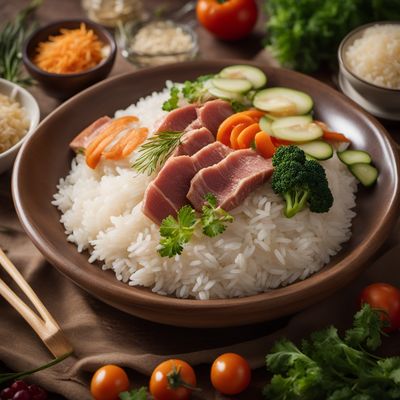
Ingredient
Milk rice
Creamy Delight: Exploring the Richness of Milk Rice
Milk rice is a dish made by cooking rice in coconut milk, resulting in a rich and creamy texture. The rice grains absorb the flavors of the coconut milk, giving it a subtle sweetness and a hint of coconut aroma. The dish has a smooth and velvety consistency, making it a comforting and satisfying meal. The rice is typically cooked until it becomes sticky, allowing it to be easily shaped into portions for serving. Milk rice is often enjoyed with savory accompaniments such as spicy curries or sambols, creating a delightful balance of flavors.
Origins and history
Milk rice has a long history in Sri Lanka and is deeply rooted in the country's culture. It is believed to have originated from ancient rituals where rice was offered to deities as a symbol of prosperity and abundance. Over time, it became a popular dish enjoyed by people of all backgrounds, especially during special occasions such as weddings, religious ceremonies, and festivals like the Sinhala and Tamil New Year. Milk rice holds a significant place in Sri Lankan culinary traditions and is considered a symbol of good fortune and unity.
Nutritional information
Milk rice is a good source of carbohydrates and provides energy. It also contains essential nutrients such as protein, dietary fiber, calcium, and iron.
Allergens
Milk rice may contain allergens such as lactose and coconut, which can cause allergies in some individuals.
How to select
When selecting milk rice, look for high-quality rice grains that are short-grained and have a good amount of starch content. The rice should be free from any impurities or foreign particles. If purchasing pre-packaged milk rice, check the expiration date and ensure that the packaging is intact.
Storage recommendations
Milk rice should be stored in an airtight container in the refrigerator to maintain its freshness. It is best consumed within 2-3 days of preparation.
How to produce
To make milk rice at home, rinse short-grain rice thoroughly and drain. In a pot, combine the rice with coconut milk and water in a 1:2 ratio. Bring to a boil, then reduce the heat and simmer until the rice is cooked and has absorbed the liquid, stirring occasionally. Once cooked, allow the rice to cool slightly before shaping it into portions.
Preparation tips
To enhance the flavor of milk rice, you can add a pinch of salt or a cinnamon stick while cooking. Shaping the rice into small portions using wet hands can make it easier to serve. Milk rice can be enjoyed on its own or paired with savory dishes such as spicy curries or sambols for a complete meal.
Culinary uses
Milk rice is commonly enjoyed as a breakfast dish or as a main course in Sri Lankan cuisine. It is often served during festive occasions and celebrations. It can be shaped into small portions and served with a variety of accompaniments such as curries, sambols, or even sweet jaggery.
Availability
Milk rice is commonly available and consumed in Sri Lanka.
More ingredients from this category

Rice, fish/seafood and vegetable based dishes
A Symphony of Flavors: Exploring the Delights of Rice, Fish/Seafood, and Vegetable Based Dishes

Paella
The Iconic Spanish Delight: Paella

Rice pudding
Creamy Delight: Exploring the World of Rice Pudding

Rice, meat, and vegetables meal
Wholesome Harmony: A Nutrient-Rich Medley of Rice, Meat, and Vegetables

Nasi goreng
"Indonesian Delight: Exploring the Flavors of Nasi Goreng"

Dolma
Delightful Stuffed Goodness

Rice and meat meal
Savory Rice Delight

Rice and vegetables meal
Harmony on a Plate: Rice and Vegetable Medley

Risotto
Creamy Delight: Unveiling the Magic of Risotto